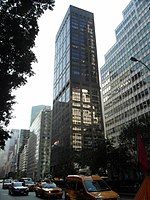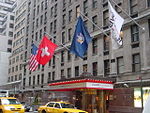Korean Cultural Center New York
Art museums and galleries in ManhattanCultural centers in New York CityKorean-American culture in New York CityMidtown ManhattanOrganizations based in New York City ... and 1 more
Park Avenue
The Korean Cultural Center New York (KCCNY) (Korean: 뉴욕한국문화원), a branch of the Ministry of Culture, Sports, and Tourism of the Republic of South Korea, is a government institution supported by the Korean Consulate General. Inaugurated in December 1979, KCCNY works to establish and promote Korean culture and aesthetics in New York through diverse cultural and artistic activities including gallery exhibitions, performing arts concerts, film festivals, and educational programs. The current director is Yun Jeung Jo.
Excerpt from the Wikipedia article Korean Cultural Center New York (License: CC BY-SA 3.0, Authors).Korean Cultural Center New York
East 57th Street, New York Manhattan
Geographical coordinates (GPS) Address Nearby Places Show on map
Geographical coordinates (GPS)
| Latitude | Longitude |
|---|---|
| N 40.762 ° | E -73.971 ° |
Address
East 57th Street 65
10022 New York, Manhattan
New York, United States
Open on Google Maps






